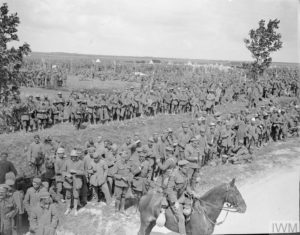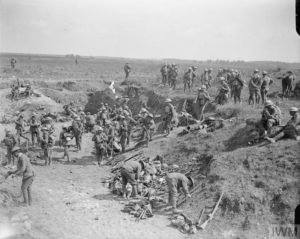Thursday August 8th, 1918
Work again. Task 30 cubic feet.
Hard Labour & Leisure
According to the programme of training and work for today, Frank and B Company are working on the Assault and Bombing Courses. Presumably Frank and his fellow Tommies are each responsible for moving 30 cubic feet of earth.
Meanwhile the Battalion’s commanding officer, Lt-Colonel Morrell has gone to the UK on home leave.
The Battle of Amiens
Today General Rawlinson‘s Fourth Army, comprising Australian, Canadian and British units, together with the French and the Americans, have launched the Battle of Amiens. New techniques, deployed successfully at the Battle of Hamel a few weeks ago, are re-used now.
One of the most important changes is surprise. Over the first few years of war, the attackers would bombard the enemy lines with heavy artillery for days in advance of the infantry assault. The alerted defenders could then take precautions.
Instead, the Fourth Army will use tanks. Artillery support will only be used immediately before the battle starts. This change was aided by improvements in the accuracy of the artillery – enabled by range charts (that removed the need for registering the guns) and aerial photographs of enemy lines.
Another change was secrecy. For example, the Canadian Corps moved over 100kms to Amiens to take part in the battle. This move was successfully camouflaged and the enemy remained unaware of troop build-up.
Since mid-1917, the Canadian Corps has been commanded by Canadian-born Sir Arthur Currie. He, like General Monash, the leader of the Australian Corps, was recognized as one of the most capable of the war-time leaders. Sir Arthur Currie began his military career in the late 1890s as a part-time gunner in the militia. As such, he is one of the few to have risen all the way through the ranks.
Outcome

On the first day, the Allies made a 20km breach of the German line and progressed 11 kms into enemy territory.
Most of the fighting was over by August 12th, by which point the Allies had advanced 19kms. The Allies took thousands of German prisoners and seized hundreds of guns and other equipment.
The first photograph shows German prisoners at a temporary POW camp near Amiens on August 9th, 1918.*
The second is of a regimental aid post near Chipilly on August 10th, 1918. Troops bring back salvage from the battlefield.^

In a few days time, Field Marshal Haig will reject the suggestion from Foch that he presses forward. Instead he will launch a fresh offensive, led by Byng’s Third Army, between the Ancre and Scarpe.
Ludendorff described the first day of the Battle of Amiens as the “the black day of the German Army”. He said this not because of the ground lost but because the morale of the German troops had been badly dented by the defeat.
By contrast, the Allies are thrilled. General Jack captures the mood in tomorrow’s diary entry, ‘The British Fourth and the French First Armies have opened a large-scale offensive between Amiens and Rheims with striking success‘.³
13th (Service) Battalion War Diary – 8th August 1918 – Haudricourt
Training etc.as per programme. Lt Col RB Campbell DSO, DI of P&BT lectured to the Brigade on the Bayonet. Lt Col JFP Morrell MVO proceeded on leave to UK.
References & Further Reading
¹ Battle of Amiens on Wikipedia
² Battle of Amiens on Britannica
³ ‘General Jack’s Diary, War on the Western Front 1914-1918’, edited by John Terraine, Cassell, 2003, first published 1964
* Q 9179, copyright Imperial War Museums
^ Q 6928, copyright Imperial War Museums


